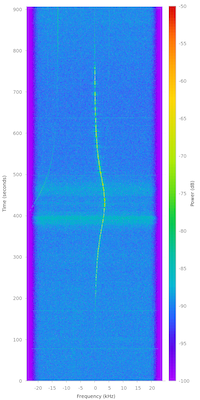Difference between revisions of "Troubleshooting Legacy"
(Created page with " == Client troubleshooting == '''Client not showing up on the network?''' * Check your settings and ensure that the API token and station ID are correct * Check your SATNOGS_...") |
|||
| Line 9: | Line 9: | ||
== Signal troubleshooting == | == Signal troubleshooting == | ||
| − | + | '''Not receiving anything?''' | |
Make sure the satellite you are testing observations against is active and recently received by others on our production network site, https://network.satnogs.org - if you click on a satellite name a popup will appear and give you the option to click on "Past Observations". If everything in the past shows red then the problem is likely with that satellite. | Make sure the satellite you are testing observations against is active and recently received by others on our production network site, https://network.satnogs.org - if you click on a satellite name a popup will appear and give you the option to click on "Past Observations". If everything in the past shows red then the problem is likely with that satellite. | ||
* SO-50 is a good satellite to use for testing as it is a strong FM voice signal assuming you have UHF capabilities. Schedule using "PE0SAT - Mode V/U FM Voice - 436.794 MHz". Here is an example to compare against: https://network.satnogs.org/observations/3334/ | * SO-50 is a good satellite to use for testing as it is a strong FM voice signal assuming you have UHF capabilities. Schedule using "PE0SAT - Mode V/U FM Voice - 436.794 MHz". Here is an example to compare against: https://network.satnogs.org/observations/3334/ | ||
* ISS is a good test for VHF as the APRS digipeater is alive again (as of this writing). When you schedule it be sure to select the APRS downlink. | * ISS is a good test for VHF as the APRS digipeater is alive again (as of this writing). When you schedule it be sure to select the APRS downlink. | ||
| + | '''Observations seem off-frequency?''' | ||
While newer SDR devices are very good and stable, there still may be some PPM drift to compensate for if you notice that signals are consistently off center. The SATNOGS_PPM_ERROR setting in /etc/supervisord.d/satnogs.ini can be used to correct for this. | While newer SDR devices are very good and stable, there still may be some PPM drift to compensate for if you notice that signals are consistently off center. The SATNOGS_PPM_ERROR setting in /etc/supervisord.d/satnogs.ini can be used to correct for this. | ||
| + | |||
| + | Make sure your clock is synced. Ensure ntp is configured and running (especially with the Raspberry Pi which lacks a real time clock) | ||
| + | |||
| + | If your signal seems to be on but drifts at the apex like in the image below, check to make sure your Latitude, Longitude, and Elevation coordinates are set properly and in the right format: | ||
| + | [[File:Waterfall_3519_2017-04-24T04-48-48_resized.png]] | ||
Revision as of 15:11, 7 May 2017
Client troubleshooting
Client not showing up on the network?
- Check your settings and ensure that the API token and station ID are correct
- Check your SATNOGS_NETWORK_API_URL, https://network.satnogs.org/api/ for prod and https://network-dev.satnogs.org/api/ for dev (and that you are using the appropriate API/ID for the site you are pointing to)
- Can you ping network.satnogs.org or network-dev.satnogs.org? Check your network connectivity.
- Check the logs for an error, /var/log/supervisor/satnogs-error.log and post to our forums at https://community.libre.space
Signal troubleshooting
Not receiving anything? Make sure the satellite you are testing observations against is active and recently received by others on our production network site, https://network.satnogs.org - if you click on a satellite name a popup will appear and give you the option to click on "Past Observations". If everything in the past shows red then the problem is likely with that satellite.
- SO-50 is a good satellite to use for testing as it is a strong FM voice signal assuming you have UHF capabilities. Schedule using "PE0SAT - Mode V/U FM Voice - 436.794 MHz". Here is an example to compare against: https://network.satnogs.org/observations/3334/
- ISS is a good test for VHF as the APRS digipeater is alive again (as of this writing). When you schedule it be sure to select the APRS downlink.
Observations seem off-frequency? While newer SDR devices are very good and stable, there still may be some PPM drift to compensate for if you notice that signals are consistently off center. The SATNOGS_PPM_ERROR setting in /etc/supervisord.d/satnogs.ini can be used to correct for this.
Make sure your clock is synced. Ensure ntp is configured and running (especially with the Raspberry Pi which lacks a real time clock)
If your signal seems to be on but drifts at the apex like in the image below, check to make sure your Latitude, Longitude, and Elevation coordinates are set properly and in the right format:
